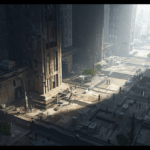Introduction
Imagine a city that grows with its people, not against them. Roads that reduce noise, buildings that breathe, and bridges that last for generations with minimal maintenance. This isn’t a futuristic fantasy—it’s the goal of sustainable infrastructure. As the world faces environmental challenges, rapid urbanization, and resource scarcity, the way we build has never been more important. But what does “sustainable infrastructure” really mean?
1. It’s More Than Just ‘Green’
Sustainable infrastructure isn’t just about adding solar panels to rooftops or planting trees along highways. It’s about designing systems, such as roads, water treatment, power grids, and transportation, that work efficiently over the long term while minimizing harm to the environment. It means using resources wisely, reducing carbon footprints, and ensuring resilience in the face of climate change.
2. People at the Center
True sustainability considers people. Infrastructure should improve lives, not just function. Well-designed public transport cuts commuting time and pollution. Green spaces reduce urban heat and support mental well-being. Walkable neighborhoods connect communities. When infrastructure supports healthy, productive lifestyles, society thrives.
3. Built to Last, Not to Replace
Traditional infrastructure often focuses on speed and cost, which can lead to frequent maintenance or early failure. Sustainable alternatives invest in durability. Think longer-lasting materials, smart sensors that predict wear and tear, and modular systems that adapt over time instead of becoming obsolete.
4. The Global Wake-Up Call
From flooded cities to energy blackouts, the consequences of outdated systems are visible worldwide. Countries, companies, and citizens are realizing that if we don’t build smarter today, we’ll pay a much higher price tomorrow.
Conclusion
Sustainable infrastructure isn’t a luxury—it’s a necessity. It’s how we future-proof our cities, support growing populations, and respect the planet we live on. As we rethink the way we build, one thing is clear: infrastructure can no longer be just concrete and steel—it must be conscious, enduring, and alive.






